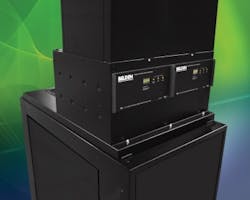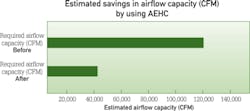Efficient cooling, improved space utilization, high-density connectivity and network convergence can reduce costs and waste.
By Denis Blouin, Belden
With energy costs rising, building owners and managers are searching for ways to improve energy efficiency, reduce costs and improve their carbon footprint. One area of the enterprise key to that effort is the data center—the IT system's central nerve center.
Studies have shown that data centers currently use as much as one to two percent of the total power consumption in the United States, and that figure is likely to increase. When seeking to find greener, more sustainable solutions, the data center is a good place to start.
Multiple approaches are available for functional areas of the data center that can help to enhance energy efficiency, improve power management and facilitate space savings. Among these are the use of Energy Star servers and high-efficiency power distribution units (PDUs). Too often overlook, however, are the physical-layer components within the data center's networking infrastructure and, arguably, these are equally important.
Essentially, there are three efficiencies to strive for in greening the data center: cooling, power management and density. This article explains why building owners and data center managers need to select the information and communication network's physical layer components with optimal performance, efficiency and sustainability in mind.
Cooling and power-management challenges
Respondents to a recent survey from Gartner (www.gartner.com) revealed that they believe power and cooling to be the top data center challenges. Today's active equipment not only consumes more operating power, but also must be kept cool. In fact, it has been estimated that cooling accounts for up to 30 percent of a data center's energy load.
However, the cooling process itself is typically accompanied by excessive energy waste as computer room air conditioner (CRAC) units attempt to compensate for hot spots. Unfortunately, the result of this compensation means that an enormous amount of energy—and money—is wasted.
Belden's AEHC Airflow Management System mounts atop an enclosure, monitors heat loads, and regulates fan-speed accordingly.
Most data centers use a hot-aisle/cold-aisle configuration to help contain hot air generated by the equipment. However, to take full advantage of this configuration, you need to find solutions that work with equipment enclosures to help separate the hot air coming out of the back of the equipment from the cold air entering the front. Such heat-containment solutions significantly reduce the mixing of hot and cold air, which increases the differential between the inlet and outlet temperatures of a CRAC unit for better efficiency and energy savings.
For example, there are heat-containment devices that mount atop enclosures and automatically monitor heat loads, and regulate fan speeds accordingly to pull the right amount of air from the enclosure for return to the CRAC unit via plenum spaces. This type of system has been shown to deliver up to 50 percent energy savings when compared to hot-aisle/cold-aisle configurations. And they enable 100 percent utilization of the existing cooling infrastructure by efficiently managing airflow.
Reducing overall data center power consumption through better power management is also highly recommended. Replacing older equipment with today's energy-efficient servers will pay dividends over time. In addition, PDUs having remote-monitoring capabilities can enable activation and deactivation of individual outlets or groups of outlets to save costs, and allow managers to view information about temperatures, humidity, airflow and smoke in the data center environment.
Finally, in arranging a control room's cabinets, racks and equipment, it's important to allow sufficient airflow to maintain optimal cooling. Careful installation, as well as maintaining neat and orderly cable rows and keeping cables away from the equipment, can be facilitated by implementing an effective, well-designed cable-management system.
This figure provided by Belden estimates the airflow-capacity savings that can be achieved using its AEHC Airflow Management System.
Saving space and reducing density
Obviously, the more square footage you have, the more materials required and the higher the energy requirements, so conserving space in the data center wherever practical is desirable. Areas such as the main and horizontal distribution rooms/areas house power-consuming core switches, as well as hundreds of interconnects and crossconnects for connecting to equipment and storage area networks. Today's marketplace offers an array of products and solutions designed to provide high performance and reliability while conserving space. There are several approaches that can be adopted in various parts of the data center.
To house equipment, efficient high-density racking systems make maximum use of available space while meeting density requirements. Some racks and cabinets feature a modular design with interchangeable components that gives users flexibility to custom-configure the equipment storage spaces to fit their specific needs and preferences.
In the main entry and telecommunications rooms, wall-mounted, high-density optical fiber and copper patching products take up less space, and can provide convenient maintenance through the use of clear, readable labels and swing-out access doors. For example, ultra high-density patch panels can accommodate 48 ports in just 1U of rack space, which is twice the density of traditional panels. Angled patch panels provide left or right patch-cord routing, eliminating the need for horizontal cable managers and providing up to 27 percent space savings in the rack.
Another solution designed for use in data center pathways is preterminated optical-fiber and copper cabling and connection systems. These conveniently bundled, factory-terminated cable assemblies provide a smaller diameter for pathway-space conservation, and are also faster and easier to install and maintain, thus saving on labor expense. Furthermore, preterminated solutions allow for use of short links, which for some data centers can result in a material reduction of up to 40 percent in the overall cabling topology. And preterminated cabling is a cost-saver over the long term in that cables can be reused and quickly repurposed to accommodate moves, adds and changes required in the future.
Going hand-in-hand with airflow-capacity savings, Belden says, are annual cooling-cost savings when using its airflow management system. Of course actual savings will vary depending on the data center's specific characteristics.
Sustainable infrastructure design
The network infrastructure is the core asset that connects enterprise users to the applications they need to communicate, perform their work and conduct transactions. In designing and installing the infrastructure, signal-transmission performance and reliability are extremely critical—and so is long-term sustainability.
High-performing cabling and connectivity components are essential for data center managers to effectively take advantage of IT efficiency practices and newer technologies such as server consolidation and virtualization that require more bandwidth. Going green and becoming more sustainable goes far beyond selecting and using environmentally friendly materials and components. It's about working smarter and more efficiently across all enterprise systems and operations, which brings us to the concept of Internet Protocol (IP) convergence.
In recent years, Ethernet and IP have advanced to where the technology can now be used to transmit voice, video, security, industrial control and building-management information as data signals across the enterprise, using a shared, common network protocol.
In some enterprises, Ethernet IP convergence is being adopted to replace a number of legacy proprietary systems. The beauty of the converged-systems approach is that it allows multiple systems to run as an open network, using the same infrastructure and cabling media, with security and authentication measures built in to protect and secure confidential data. IP convergence is a trend that likely will grow over time because it serves to increase efficiency, reduce costs and waste, and maximize resource utilization. And, in the end, isn't that what sustainability is all about?
Denis Blouin is program manager for data centers with Belden (www.belden.com). He is a mechanical engineer with more than 20 years' experience in networking-system process, design and applications.
More green than meets the eye
Our cover story last month provided information on the Environmental Protection Agency's relatively new Energy Star for Data Center Facilities program. (See "Few data centers earn Energy Star label," May 2011, p. 17.) As the story's title indicates, only a handful of data center facilities are listed as having earned the Energy Star label.
In researching the facilities that have earned it, we found statements from Citi (www.citi.com) indicating that one of the bank's facilities in the Midwest United States had earned the label. Yet the list of labeled facilities available on the EPA's Web site does not include Citi.
Why, we wondered? A spokesperson for Citi explained to us that the list on the EPA's site includes each facility's physical address. For reasons of security, Citi has chosen not to be included on that list.
Additionally, since that article went to press, two more data centers have earned the Energy Star label and are listed by the EPA: an AFLAC facility in Columbus, GA and a Corp 7 facility in Johnston, IA. -Ed.

